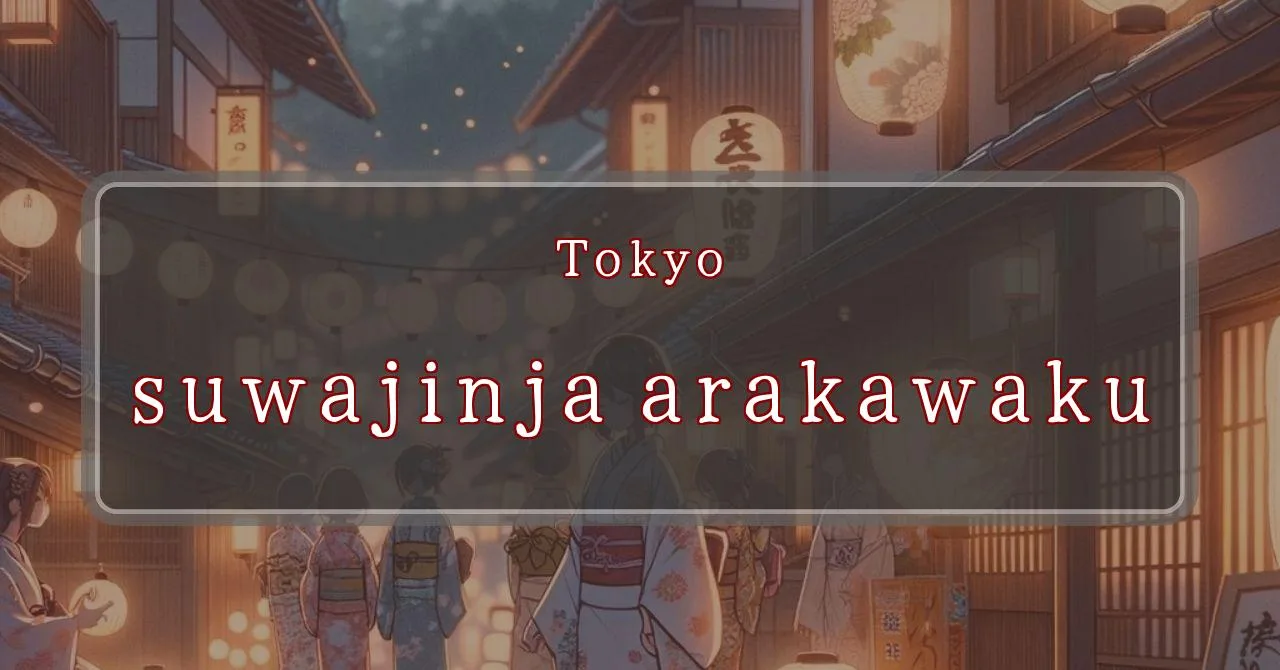Gleaming lanterns illuminate the twilight at Suwa Shrine’s grand festival.
Basic Information
Suwa Shrine is a Shinto shrine located in Nishi Nippori, Arakawa, Tokyo, Japan. It is dedicated to the god Takeminakata-no-Mikoto, the deity of agriculture, water, and wind.
- Address: 3-4-8 Nishi Nippori, Arakawa-ku, Tokyo 116-0013
- Phone Number: 03-3821-4275
- Access: 3-minute walk from Nishi Nippori Station on the JR Yamanote Line and Tokyo Metro Chiyoda Line
- Festival Days: August 24th (Sat), 25th (Sun), and 27th (Tue), 2024
Main Events and Attractions of the Festival
The Suwa Shrine Festival is a three-day festival held annually in late August. It is one of the most popular festivals in Arakawa, attracting large crowds of visitors each year.
Mikoshi Procession
The highlight of the festival is the mikoshi procession, which takes place on the final day of the festival. A mikoshi is a portable shrine that is carried through the streets by a team of people. The Suwa Shrine mikoshi is particularly large and heavy, and it is carried by a team of over 100 people.
- Overview: A parade of portable shrines through the streets
- Features: Large and heavy mikoshi carried by a team of over 100 people
Kagura Performance
Another popular attraction of the festival is the kagura performance. Kagura is a traditional Japanese dance and music performance that is often performed at Shinto shrines. The kagura performance at Suwa Shrine is particularly elaborate and beautiful, and it is a must-see for visitors to the festival.
- Overview: Traditional Japanese dance and music performance
- Features: Elaborate and beautiful performance by skilled kagura dancers
Food Stalls
No Japanese festival is complete without food stalls, and the Suwa Shrine Festival is no exception. There are dozens of food stalls lining the streets around the shrine, selling a variety of delicious Japanese foods, such as yakitori, takoyaki, and okonomiyaki.
- Overview: A variety of food stalls selling delicious Japanese foods
- Features: Yakitori, takoyaki, okonomiyaki, and many other popular dishes
Blessings and Deities
Suwa Shrine is dedicated to Takeminakata-no-Mikoto, the god of agriculture, water, and wind. He is also known as the god of victory and good luck. People pray to Takeminakata-no-Mikoto for success in their endeavors, good harvests, and protection from natural disasters.
- Takeminakata-no-Mikoto: God of agriculture, water, wind, victory, and good luck
- Benefits of praying: Success in endeavors, good harvests, protection from natural disasters
Origin and History
The origins of Suwa Shrine are unclear, but it is believed to have been founded in the 13th century. The shrine was originally located in a different part of Arakawa, but it was moved to its current location in 1635. Suwa Shrine has been a popular place of worship for centuries, and it is now one of the most important Shinto shrines in Tokyo.
- Founded: 13th century
- Original location: Different part of Arakawa
- Current location: Moved in 1635
- Significance: One of the most important Shinto shrines in Tokyo
Tips and Notes for Visitors
If you are planning to visit Suwa Shrine during the festival, here are a few tips:
- Arrive early to avoid the crowds.
- Wear comfortable shoes, as you will be doing a lot of walking.
- Bring a camera to capture the beautiful sights of the festival.
- Be respectful of the shrine and its customs.
Parking Information
There is limited parking available at Suwa Shrine. If you are driving, it is best to arrive early to secure a parking spot. You can also use public transportation to get to the shrine. The nearest station is Nishi Nippori Station on the JR Yamanote Line and Tokyo Metro Chiyoda Line.
- Limited parking available at the shrine
- Arrive early to secure a parking spot
- Public transportation recommended: Nishi Nippori Station on JR Yamanote Line and Tokyo Metro Chiyoda Line
Popular Stalls and Food Carts in Recent Years
| Type of Stall | Description |
|---|---|
| Takoyaki | A staple at Japanese festivals. Characterized by a crispy outside and a creamy inside. |
| Jaga Butter | A simple yet popular snack of hot potatoes lavishly topped with melted butter. |
| Baby Castella | Small castella cakes, sweet and fluffy treats enjoyed by children and adults alike. |
| Grilled Ayu with Salt | Fresh ayu fish grilled whole with salt, a savory taste of Japanese summer. |
| Shaapin | A unique gourmet item influenced by foreign cuisine, with a chewy skin wrapping the filling. |
| Okonomiyaki | A Japanese grilled dish where you often choose your own ingredients for a personalized flavor. |
| Cotton Candy | A fluffy, sweet snack that’s extremely popular with children. |
| Chocolate Banana | A banana coated in chocolate, a fun and visually appealing dessert. |
| Kushiyaki | Various types of ingredients skewered and grilled, an easy-to-enjoy snack. |
| Yakisoba | Fried noodles mixed with a special sauce, a fast food favorite in Japan. |



